Translations 677
Food Self-Sufficiency and National Security

Food Self-Sufficiency:
A Matter of National Security
Granma publishes the remarks of Prime Minister, Manuel Marrero Cruz, at the 32nd anniversary of the Urban, Suburban and Family Farming Program in the municipality of Segundo Frente, Santiago de Cuba
Author: Manuel Marrero Cruz | internet@granma.cu
February 16, 2020 21:02:00
Translated and edited by Walter Lippmann for CubaNews.
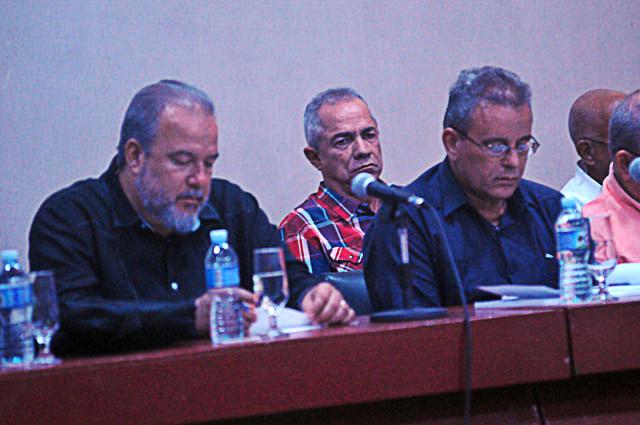
Photo: Sierra Maestra newspaper
Compañeras and compañeros of the presidency and invited guests;
Delegates to this important work meeting:
More than three decades ago, on December 27, 1987, during a visit to an experience of growing vegetables in quarries enriched with organic matter in Hortifar, an entity belonging to the Military Agricultural Union, the Army General [Raul Castro] indicated to analyze and develop this method of cultivation. This is how the Urban Agriculture Program was born.
Years later, this type of quarry became part of the environment in every corner of Cuba, from the big cities to the small towns.
Then the idea emerged, also from the Army General, to increase the scale of those crops to the lands around the cities, which in their great majority remained unproductive.
As you will remember, this came to be on April 8, 2009, first in Camagüey, within a radius of ten kilometers from the center of the provincial capital. It was called suburban agriculture, and wisely integrated into the by-then already consolidated urban and family agriculture. It was under the direction of comrade Adolfo Rodríguez, known affectionately by all of us as Adolfito. With such passion, responsibility and efficiency he took on the task, practically until the last moment of his life, and to whose commitment we owe a great deal of what was achieved. May this event serve to honor his memory.
The concept has remained unchanged: to generalize a system of food production based on local potential, that is, creating there their own technologies and productive inputs by using the potential available in the territory.
Undoubtedly, since then, progress has been significant. The program has been consolidated as a popular movement of a productive extensionist nature and under agro-ecological principles. This is done with the use of sustainable production technologies, the use of local resources, and the combination of experience and traditions with science and technology.
It is a dynamic, deep, vertical, coordinated and directed work system through the National Group. This has allowed us to achieve positive results and with it, important savings to the country’s economy, contributing to the decrease of input imports.
At a time when the U.S. government has tightened the blockade and everything indicates that it will continue to do so, this project aimed at producing food for the people. It’s something that is not simply another priority, takes on much more importance. It is a vital issue for national security, I repeat, something that is not simply another priority; it is a vital issue for national security, which is equal to preserving our independence and sovereignty.
Today, our country imports $1.65 billion in food for the people, so replacing those imports is strategic. We must commit ourselves to the development of this program and extend its various productive structures to our cities, up to 10 square meters per inhabitant by next year. To take advantage of all available spaces in the cities or towns.
There are plenty of reasons to defend this strategy. In the first place, it is the most economical way of producing food. It can work with a minimum of motor transport and fuel – even without any if necessary – as people can buy them where they are grown, or the transport is a short distance and allows the use of alternative means.
Another very important point: it does not require imports of pesticides or fertilizers. Each hectare of quarry committed must be supported by the amount of fertilizer and other organic inputs needed.
In addition, it guarantees employment for thousands of workers, including women and young people. It is an elementary tool for achieving food security. It contributes to improving water management and nutrient recycling. It allows the use of unproductive, idle or underutilized spaces and is capable of producing the seeds it demands, among other advantages.
All this makes it a realistic and sustainable alternative, a reference for what we have to do to achieve food and nutritional sovereignty for our population.
It is fair and necessary to recognize what has been achieved, but you know, and you analyzed it during the event, that even greater results can be achieved with the resources available today, if we use them with the maximum of rationality and intelligence.
No one can feel satisfied until the last disused quarry and organoponico is recovered. The goal is to repair them all and put them into use during the current year. Likewise, to complete the reconstruction of the protected and semi-protected cultivation areas affected by meteorological phenomena or by the logical deterioration of the years of exploitation.
The yield per square meter must be increased. There are plenty of examples of what is possible when quality seeds are used and with a constant application of organic substrates and fertilizers, as well as the appropriate use of bio-products and agro-technology.
The use of animal traction in cultivation work around towns and villages should be a constant, whether or not fuel is available. In addition to the efficient use of water and renewable energy sources, such as biogas, windmills, solar panels, biomass and other alternatives, depending on the possibilities in each location.
We cannot stop at the incorporation of idle areas, covered with marabou and other weeds, in the surroundings of population settlements and communities.
It is also important to guarantee production throughout the year; not to neglect the summer under the excuse of unfavorable weather. In those months we have to promote products that are more resistant to heat, such as cucumbers, eggplants, beans, and okra, among others.
We must perfect the marketing of fresh vegetables and fruit, with emphasis on the population, but without forgetting tourism, social consumption, defense, and the internal order, and we must even get to export some products.
Closely linked to these purposes is the objective of continuing to adjust the organizational system of Urban Agriculture. It is necessary to analyze its financial structure and measure its impact, to ensure adequate profitability and stability in the results.
The Municipal Urban Farm and its representatives of the people’s councils must exercise a broad power of convocation among local producers. In turn, they must play the productive, political and social role for which they were created. It is necessary to work hard to re-establish the marketing network that will simplify and facilitate the acquisition of agro-products directly for the local population.
The success of this great effort has a decisive key: the women and men who make the land produce. It is essential to continue to increase the incorporation of the labor force into this activity, especially young people, and to perfect the systems of payment by results.
Also from Urban Agriculture, the fruit tree program was born, which was incorporated into the local supply in all the perimeter of our localities.
Regarding this program, Army General Raul Castro Ruz suggested to create a fruit tree cooperative in each municipality and today we can report with satisfaction that we have 353 cooperatives throughout the country, dedicated to the production of fruit for the people.
With regard to food production in general, today more than ever we have to promote polyculture.: It is not the same to invest in fuel, fertilizers and other resources to prepare the land and sow a single crop than to take advantage of the same for two and three more.
Compañeras and compañeros:
We had proposed to guarantee 30 pounds per month of food and vegetables to each fellow citizen,. Of those, we reached 20 in 2019. We will reach that goal in less time if we continue to increase the productive areas, from the backyards, the orchard, the giant organoponicos and suburban agriculture, to the large productive poles.
To do this, we must continue to produce high-quality seeds. Research centers already show positive results with seeds that are better adapted to our climate, increase yields and even reduce production cycles.
Another objective is to guarantee each Cuban five kilograms of animal protein per month, and last year we only reached 200 grams. It is unsustainable to try to increase the production of animal protein-based on imported feed and raw materials, in which we are investing 450 million dollars today. It is as much of a priority to produce animal feed as we consume directly as people.
We Cubans have inherited as a food tradition a diet made up of four basic products: rice, beans, food and protein, to which we should add vegetables or salads. Of these, we now have total sovereignty over only one: food. We import an important part of rice, and to a lesser extent, beans and meat, but also in considerable volume, and even a level of vegetables.
Our future has to be directed towards achieving food sovereignty. We have to aim for this in stages, the shorter the better, planned and well-coordinated in a comprehensive way through realistic plans. It is precisely vegetables and beans that we can stop importing in the short term.
We are convinced that this program will continue to grow and will play an important and irreplaceable role in achieving these strategic objectives.
We congratulate you on the results achieved in 2019 and we urge you to continue to move forward as a national reference in the production of food for the people and thereby demonstrate that Yes we could, Yes we can and Always we will.
Thank you very much.
Public-Private Strategic Alliance in Cuba
Governance from a Public-Private Strategic Alliance in Cuba
March 6, 2020
Translated and edited by Walter Lippmann for CubaNews
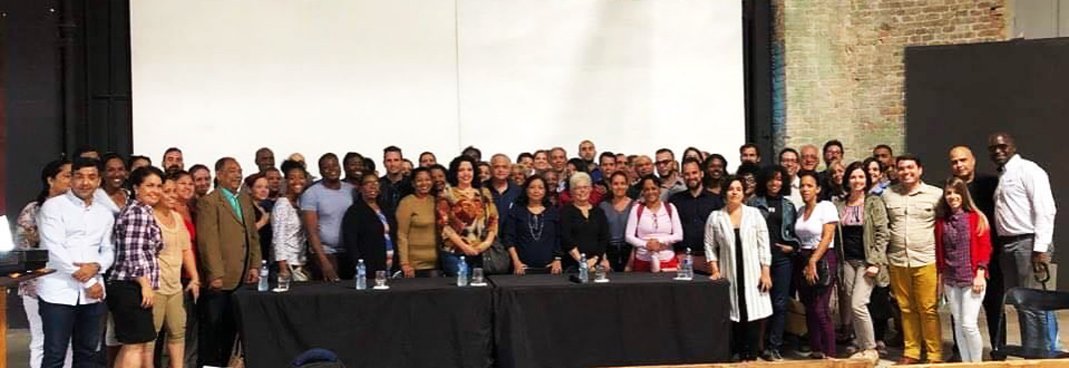
Text: CEAP collaboration
Considering the will of the private sector as a high strategic value for a city and reconciling concrete actions to transform not only the physical spaces but also the culture of life is magnanimous in these times. This was endorsed in the first workshop: governance from a public-private strategic alliance in Cuba. It was a meeting between the government and a large group of entrepreneurs from the capital.
The workshop, on this occasion, was convened by the Center for Public Administration Studies (CEAP), belonging to the Alma Mater of Cuban Higher Education. It’s part of a joint effort with the Public Administration Network of the aforementioned Center for the Study of Public Administration, and the Entrepreneurship and Innovation Network of the Center for the Study of the Cuban Economy, in a conjunction of efforts and interests.
The meeting was held in response to the need and demand to create a space for exchange in the interest of presenting, debating and exchanging needs, potentialities, experiences and proposals, among others, aimed at promoting local development projects, as well as fostering links between the State and non-State sectors and foreign investment.
Its development was attended by the Coordinator of Economy in the Government of Havana, Jorge Luis Villa, as well as the economic coordinators of all the municipalities of the province and some Municipal Directors of Labour. The University of Havana was represented by the Director of the Center for the Study of Public Administration and the Cuban Economy, Dr. Noris Tamayo Pineda and Dr. Betsy Anaya Cruz, respectively, as well as the Presidents of the Public Administration and Entrepreneurship Networks, belonging to each of the aforementioned, in addition to academics linked to each of the aforementioned research centers.
Among the more than 70 participants, and during 6 hours, assertive communication and immediate commitments prevailed. It is to carry out in the next months the First Exhibition Fair with an international scope. There the creators of goods and services by their own efforts will not only make known their products, but also offer all kinds of possibilities and opportunities for the community’s integral development; it was established the need to transform at local scale and through the interactions, in such a way that it reaches to energize the different sectors (state and non-state) as an intention prioritized in the Project of social economic development of the country.
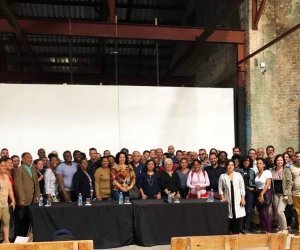
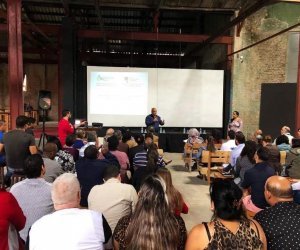
State Gastronomy: Everything in CUP

Gastronomic Services of State Commerce: Everything in CUP
It should be noted that there are more than 7000 state-run restaurants, bars and other catering establishments in the country, and only 10 % of them were allowed to sell in dual currency.
by Yaditza del Sol González
March 4, 2020
Translated and edited by Walter Lippmann for CubaNews.
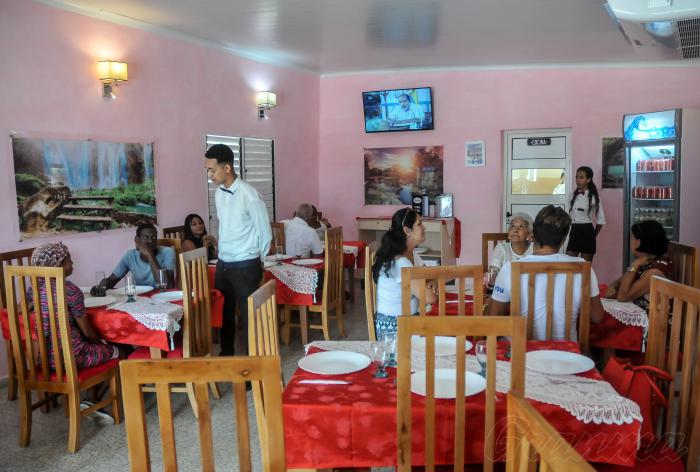
The elimination of cucumber sales in these establishments is intended to achieve greater control in the management of trade and gastronomic activities, as it allows a single accounting record to be established for the products marketed. Photo: Ariel Cecilio Lemus
The units of the state trade system that provide gastronomic services already carry out all their commercial activities in coupons, and payment in cucumbers is not appropriate for the purchase of certain products that were previously sold in this currency, such as beers, soft drinks, cigars, water, ice cream, jams and alcoholic beverages.
All these commercial actions will be carried out only in CUP, taking into account the current conditions of automation of the accounting systems of these units.
Arturo Vazquez, director of organization and systems of the Ministry of Interior Commerce (Mincin) explained that this measure is part of the improvement of retail trade of local subordination and does not include the chains of stores in foreign exchange, whether TRD, Palmares, Cimex or others, nor the Sylvain.
This is undoubtedly a measure that has caused great concern among readers, whether because of the lack of institutional communication prior to the effect of such a procedure, consumers’ concerns about the existence of exchange funds or about the conversion rate applied to goods.
According to the Deputy Minister of the sector, Miriam Perez, the elimination of the sale in CUC in these establishments is a response to the purpose of achieving greater control in the management of commerce and gastronomic activities, since it allows for the establishment of a single accounting record of the products marketed.
It should be pointed out that there are more than 7000 units in the country that carry out gastronomic activities on a State basis, i.e. bars, restaurants and others, and only 10% were authorized to sell in dual currency.
This group was selected as part of a scheme that, at the time, allowed the Trade to be self-financing in CUC, in addition to being an element of support for the budgets of other expenses, commented the Deputy Minister. This meant that, in the same restaurant, certain offers were paid in coupons and others in CUC, which had become a recurrent complaint from consumers.
Yosvany Pupo, general director of Services of the Mincin, explained that what was assumed is not part of a previous measure to the process of monetary unification, but that it responds to the improvement of the management of the commerce and cannot be analyzed out of that context. “In addition, there is no price increase in what we offer and, therefore, the Cadeca conversion rate of 1 CUC x 25 cup is applied,” he explained.
However, in the case of products that had official price lists in CUP, the price already established is assumed. For example, the domestically-produced canned soft drink, which used to be sold at .50 CUC, now costs 10 CUC, and not 12.50 CUC.
Offending Carriers Do Not Go Unpunished

Offending Carriers Do Not Go Unpunished
As a result of the allegations of popular control, an information note announced that measures were applied to 208 incumbents and contractors, the most frequent forms of indiscipline being price violations and travel restrictions.
March 4, 2020
Translated and edited by Walter Lippmann for CubaNews.

Some private individuals contribute to the movement of the population. Photo: Endrys Correa Vaillant
Cuba does not live with impunity, which is why the people feel supported by the measures taken against those who violate the stipulations of the Council of the Provincial Administration of Havana, regarding the maximum prices to be charged by private transporters circulating in the capital.
The General Directorate of Transport in Havana reported that 62 transport operation licenses had been withdrawn from the holders and 44 vouchers from their contracted workers, in addition to 199 contraventions.
As a result of complaints by the popular control, an informative note announced that measures were applied to 208 holders and contracted workers, with the most frequent forms of indiscipline being violations of prices and the limitation of trips.
Similarly, 11 vehicles were found to have committed repeated violations, to which cancellation measures were applied (table 1), as well as 45 vehicles whose drivers do not have an operating license (table 2).
In response to the country’s call to join forces in the fuel crisis caused by the impact of the U.S. blockade, it was also evident that some state car drivers remained non-compliant by not stopping at the places with the highest concentration of people.
In the month of February, 983 vehicles were reported and 773 measures were applied to different agencies and entities, including the ministries of Construction, Transportation, Public Health, Communications, Agriculture, Industry, Energy and Mines, Culture, Food Industry and Tourism, the Business Administration Group, Water Resources, as well as religious institutions and agencies.
Likewise, it is worth noting that there are still 46 entities that have not applied the measures corresponding to the offenders, which will be summoned to analysis by the Governor, as part of the approved organizational measures.
The population has the right to demand compliance with the provisions regarding maximum prices for private carriers.
In the event of non-compliance, it can report it through the different established channels, informing the registration number, date, time and place of the event, by telephone: 188820 or 7-881-9264 of Attention to the Population of the General Directorate of Transport.
Also, through the websites: www.dgtph.transnet.cu, of the General Directorate of Transport, and www.lahabana.gob.cu (the Citizen’s Portal).
Also, through the e-mails: oap@getrans.cu, centrollamadas@getrans.cu, and atencionciudadana@mitrans.gob.cu, of the Mitrans.
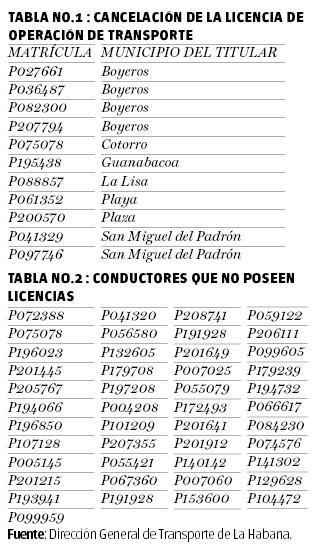
Evo Denounces Manouvers Against MAS

Evo Morales Denounces Maneuvers of
the De Facto Government Against MAS
The former president of Bolivia, Evo Morales, made this Tuesday, through his official Twitter account, a call to the international community to accompany the Bolivian people in the upcoming elections.
March 4, 2020
Translated and edited by Walter Lippmann for CubaNews.
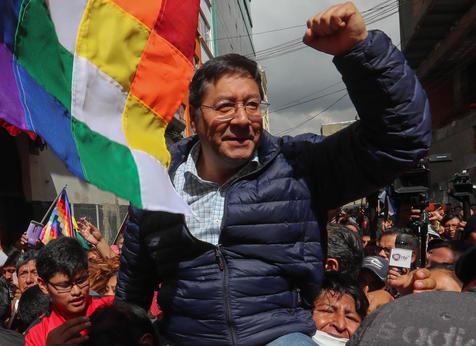
Thousands of people who support the Movement Towards Socialism joined to register the Arce-Choquehuanca binomial for the May 3 elections. Photo: ANSA
The former president of Bolivia, Evo Morales, made a call to the international community to accompany the Bolivian people in the upcoming elections through his official Twitter account on Tuesday.
Morales announced that the coup leaders will try to disqualify the candidates of the Movement Towards Socialism (MAS) before May 3rd.
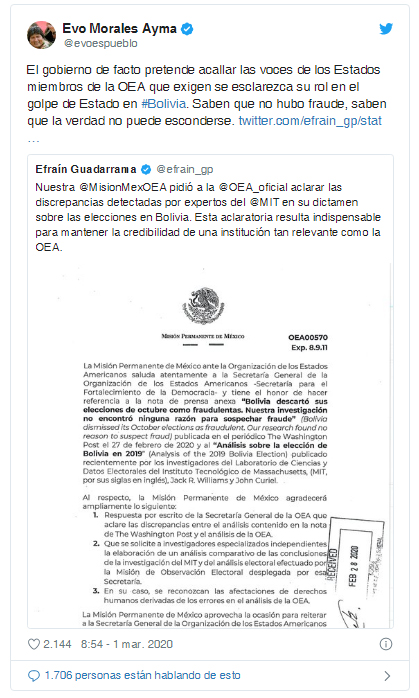
According to a survey released by the Bolivian TV channel ATB, MAS, which places former Economy Minister Luis Arce as a candidate for President and former Foreign Affairs Minister David Choquehuanca as Vice President, at a 32.6% voting intention.
Then comes Comunidad Ciudadana (cc), with 19.2%, which again presents Carlos Mesa as a candidate for President, and Gustavo Pedraza to be elected Vice President.
In the poll, the Juntos alliance also took a position, led by the self-proclaimed interim president, Jeanine Áñez, and Samuel Doria Medina, who accumulated 18.2%.
If these figures are repeated during the official vote, a second round of voting should be held. It is required that a candidate must have more than 50% of the votes or 40% with a 10-point lead over the runner-up to win directly.
Huawei Wants to Replace Google Search

Huawei Wants to Replace Google Search With Its Own Search Engine
March 4, 2020
Translated and edited by Walter Lippmann for CubaNews.

Huawei’s billboard at PT Expo, Beijing, China, October 31, 2019. Photo: Mark Schiefelbein/AP.
Replace Google Search. That is the purpose of Huawei, which is developing an Internet search engine for its mobile devices, according to the media XDA, which participated in the testing of the beta version of that application which the Chinese technology began to develop last week.
Huawei Search works as a basic search engine that helps to find websites, news, videos or images on the Internet, while offering shortcuts to consult information about the weather or currency exchange.
However, this solution is not connected to other programs, while Alphabet’s company search engine does have links to utilities such as “podcasts” or Google Assistant.
This service is operated by Aspiegel Limited -Huawei’s subsidiary in Ireland- and could work on the Chinese technology’s own search engine, without the need to incorporate external search programs.
Although at first the company invited anyone to participate in this initiative, as of February 29th it stopped the beta testing of Huawei Search because of its “concerns” related to the “misuse” of the app in social media.
The Chinese technology company has promoted this project because it cannot use certain US technology services since 2019.
It also happens that some Huawei mobiles cannot use certain Google services since last year, when the US government blacklisted the Chinese firm, preventing it from acquiring components from US companies without Washington’s approval.
Cuban Medical Collaborators in Chinese Hospitals

Cuban Medical Collaborators Resume Activities in Hospitals in China
March 1, 2020
Translated and edited by Walter Lippmann for CubaNews.
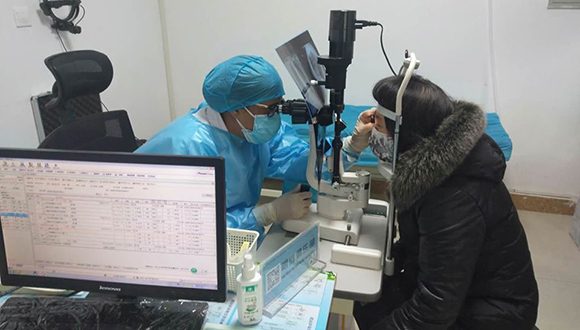
Cuban health workers in China. Photo: Cuban Medical Cooperation in China/Facebook.
Ophthalmologists from Cuba’s Medical Brigade in China have been continuing their assistance activities in three hospitals in the country since Tuesday, with responsibility and the necessary protection in the midst of the emergency caused by the outbreak of the Covid-19 coronavirus.
The mission, led by Dr. Yamira Palacios, confirmed that work was resumed after the suspensions adopted for security reasons, and as part of the national contingency plan implemented since late January.
She said in the social networks that the Cuban collaborators together with the Chinese health professionals are still linked despite the complex epidemiological situation in the country, with responsibility for their health care and protection to avoid exposure to the greatest risk.
The Brigade added that the priority is to prevent, maintain control and comply with the measures to confront the coronavirus.
This gesture is another sign of love, unity, solidarity and commitment,” she concluded.
The Cuban collaboration is developing with good results in ophthalmological centers installed in mixed hospitals in the provinces of Qinghai, Shanxi and Henan.
Official figures show that between 2012 and 2019 alone, more than 225,627 consultations and 13,546 surgeries were performed.
A couple of days ago, the Brigade reiterated its support and confidence in the efforts of the Chinese government to stop the Covid-19 in the shortest time possible. In addition, the Brigade to highlighted the discipline and compliance with the actions carried out by the health authorities of the Asian giant and those of the Cuban embassy here.
“To this day no Cuban in China has fallen ill. The result of hard teamwork. Counting on truthful and timely information without issuing a single opinion that was not supported by science, nor additional measures, without alarmism or collective panic,” he said.
She highlighted the reinforcement of the team with pediatric infectious disease doctor Ileana Alvarez and clinical infectious disease doctor Rafael Arocha. Both are recognized physicians of the Henry Reeve Contingent and whose incorporation was considered another sign of kindness and solidarity of the Cuban health system.
“We will continue on the path that will lead us to control this contagious and still unknown disease (…) that has filled the Chinese people with pain, sadness, and uncertainty,” he said.
Dr. Palacios, along with Alvarez and Arocha, are in charge of the medical post established in the Caribbean island’s embassy to reinforce health care for compatriots in China in the midst of the emergency due to the outbreak.
The team provides assistance and consultations, follows up on the current epidemiological situation, and also supports the preventive work that the diplomatic mission implemented in order to be more effective in guiding and protecting its fellow countrymen.
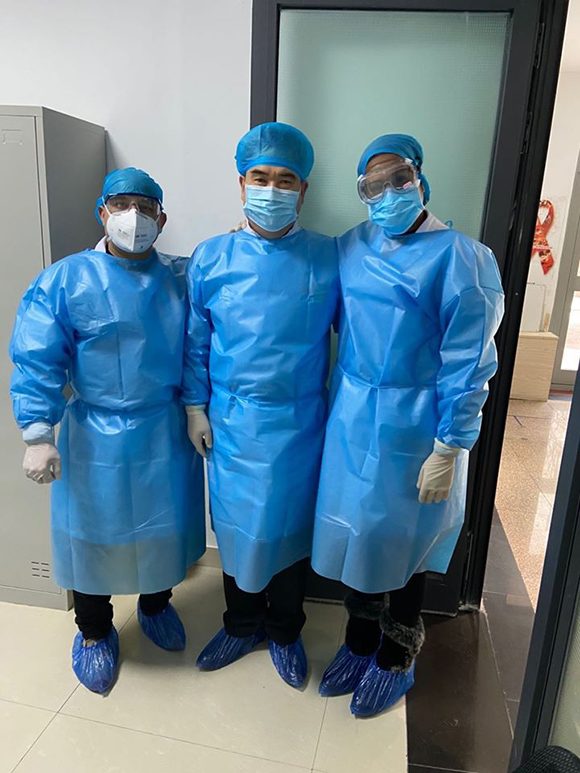
Cuban health workers in China. Photo: Cuban Medical Cooperation in China/Facebook.
For a More Inclusive Society

For a More Inclusive Society
The 5th Congress of the Cuban Association of the Deaf takes place at the Havana Convention Center
By Liudmila Peña Herrera
March 4, 2020
Translated and edited by Walter Lippmann for CubaNews.
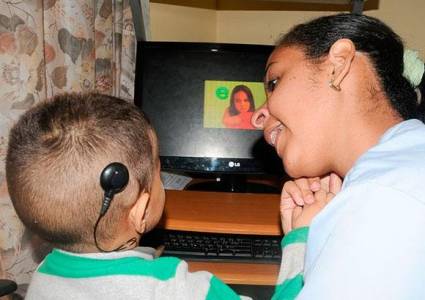
Cuba offers an inclusive education Author: Taken from the Internet Published: 04/03/2020 | 12:40 am
The demand of the deaf community that Cuban sign language be accepted as an official language, along with Spanish, was evident on the first day of the 5th Congress of the Association of the Deaf of Cuba (ANSOC), which is in session at the Havana Convention Center since Tuesday.
The speakers highlighted the richness of this form of communication, the academic research on its development and the need for families to have the opportunity to study and communicate through it, as it is a symbol of inclusion.
In one of the panels at the conference, aspects related to the linguistics of Cuban sign language and the culture of the deaf community, the methodology for teaching it to children, society’s knowledge of the potentialities and needs of these people, as well as the importance of sign language being protected by law were addressed.
In this sense, Leonardo Pérez Gallardo, professor of Civil Law at the University of Havana, reflected that in its Article 42, the Constitution prohibits any type of discrimination on the basis of disability, and one of the specific manifestations of disability is hearing.
A touching moment was the presentation of the video clip Soy el verso, with music by Telmary, performed in sign language, and the message that the artist sent, from there, to her colleagues: “It is important that society hears the concerns of the deaf community and the efforts made in the country in their favor. I hope that many artists can join in”.
The first day of the Congress was attended by Jorge Cuevas Ramos, member of the Secretariat of the Central Committee of the Party; Marta Elena Feitó Cabrera, Minister of Labour and Social Security; Joseph Murray, President of the World Federation of the Deaf; Fermín Quiñones Sánchez, President of the Cuban Association of the United Nations; and Alejandro Marzo Peña, President of the ANSOC.
The Four-Step Commitment

The Four-Step Commitment of New Young UJC Members
The selection of the first four direct delegates to the 11th Congress of the UJC in Santiago de Cuba shows that every day and from the most diverse fields, the tenacity of the new ones contributes its grain of sand to the forging of the future
By Odalis Riquenes Cutiño
Published: Thursday 20 February 2020 | 05:59:34 pm.
Translated and edited by Walter Lippmann for CubaNews.
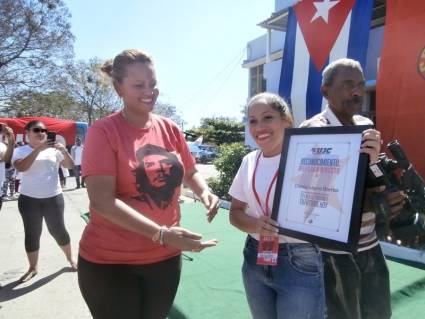
Danay Leyva Barrios, hydraulic engineer and a pillar in the investments of the Provincial Delegation of Hydraulic Resources santiaguera Author: Odalis Riquenes Cutiño Published: 20/02/2020 | 05:55 pm
SANTIAGO DE CUBA.-Wilfredo Valdés Pérez, specialist in quality control at the Hermanos Díaz refinery; Danay Leyva Barrios, hydraulic engineer and a pillar in the investments of the Santiago Provincial Delegation of Hydraulic Resources; Beatriz García Vistel, who is training as an Early Childhood Educator at the Floro Pérez Pedagogical School and Dainier González Romero, fourth-year Telecommunications Engineering student at the Universidad de Oriente, were selected in their respective centers as direct delegates from this eastern province to the 11th Congress of the UJC.
Excited, each in their own way, among the hugs of their colleagues, the joy of their administrative leadership, and the respectful tribute to the merit of those who shared the candidacies with them, they received their credentials and recognition from the hands of the member of the National Bureau of the UJC, Yannara Concepción Domínguez, and reaffirmed their commitment to continue firm and moving forward, contributing to the present and underpinning a better future.
Wilfredo, Danay, Beatriz and Dainier are the faces of continuity and their stories of anonymous and daily devotion, the best evidence that the new Cubans are the protagonists of their time, and in their walk there are guarantees for tomorrow.
A graduate in Chemistry, Wilfredo is the youth leader of the Santiago fuel refinery, a center with a tradition of good work from the UJC and where, united by a shared vision, the Bisoño people are a true vanguard for carrying out any task of high impact or difficulty that may arise.
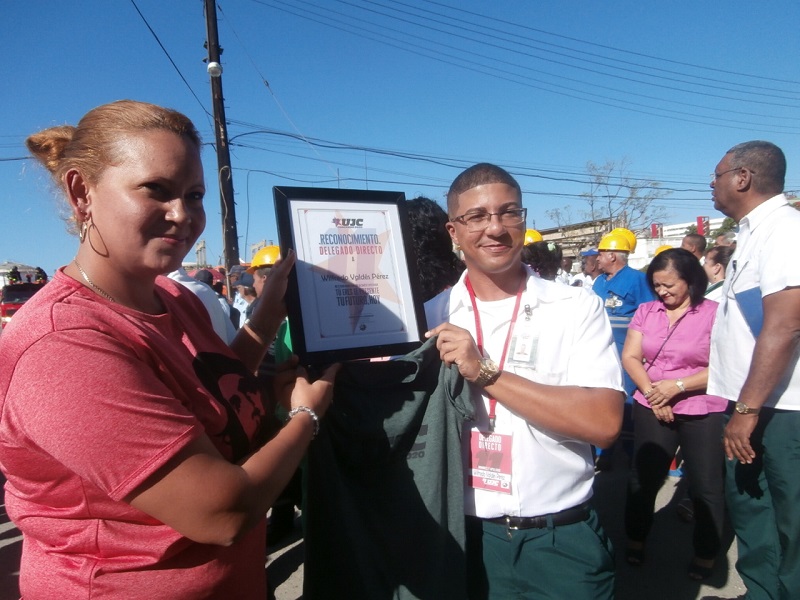
In addition to working long hours in all areas of the plant to secure the fuel demand in eastern Cuba, the novices set the pace if a substation affected by a fire needs to be repaired, a cooling tower needs to be dismantled, or an oil spill threatens the bay.
Danay Leyva Barrios, a specialist in water resource management and development, will raise her voice at the great gathering of the young Cuban vanguard, on behalf of those who from dawn to dusk are wasting sacrifices, whether in new investments, in dealing with drought or in daily water management, without expecting any reward other than a “thank you” from the population that has benefited from the precious liquid.
At only 17 years old and the love for history and children in her warm eyes, Beatriz García Vistel is the living example of the values of the girls who are trained at the Floro Pérez Pedagogical School, a center that has been outstanding at a national level for four consecutive years. There future early childhood educators are prepared, ready to continue the achievements of the Revolution in this sector.
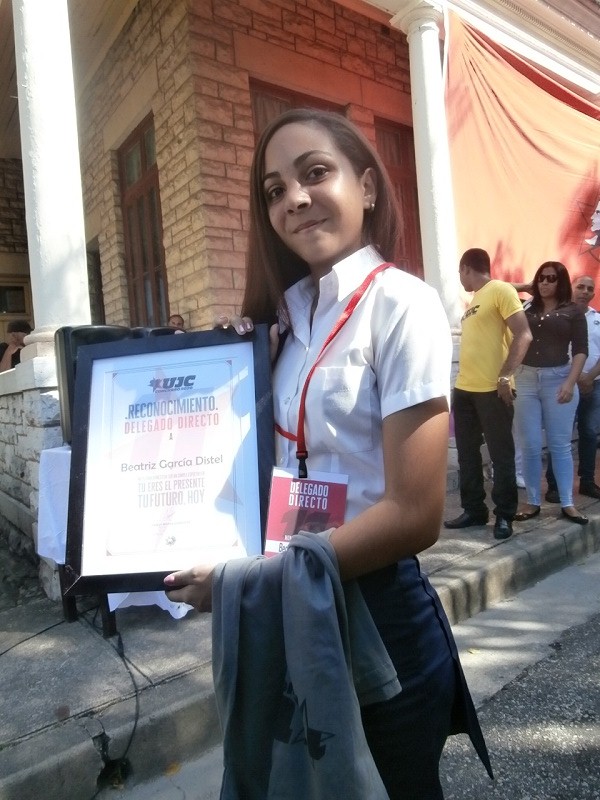
Only two courses away from graduating as a telecommunications engineer from the Universidad de Oriente, Dainier González is already dreaming and striving for a tomorrow where, he says, science, which he is passionate about, and the research that can be generated from academia, will be put to work on the dilemmas of local development.
That is why he already speaks, passionately, of the use of robotics in the development of assisted rehabilitation technologies for patients affected by neurological diseases. This will be his degree thesis, because, in this way, he assures us, he will be at the level of the prepared and committed professionals who are trained in the country.
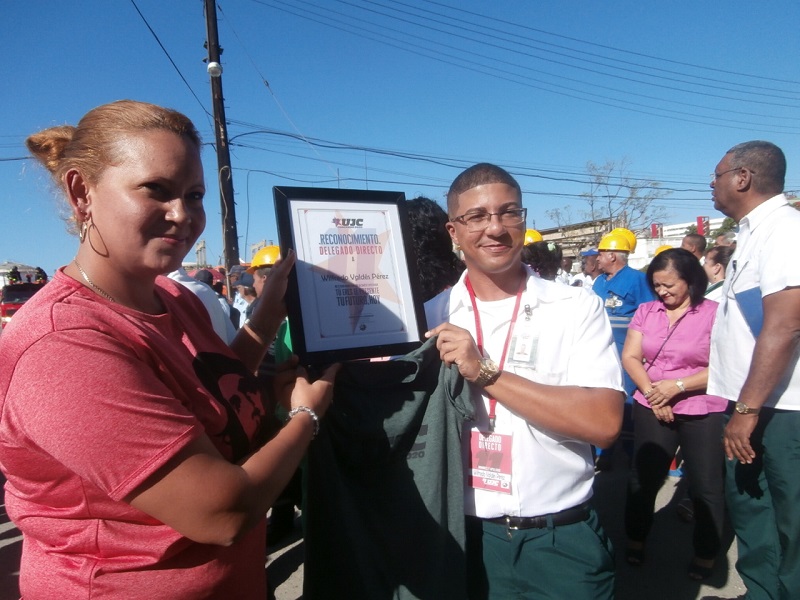
Today they are Wilfredo, Danay, Beatriz, Dainier, four among thousands in Santiago, in Cuba; party lovers, addicted to technology, but also industrious and dedicated, every day and from the most diverse fields, to forging the future of the Homeland.
These are the signs of continuity, real, concrete, beyond any slogan.
U.S.-Backed Deal Exposed

ISRAEL-PALESTINE CONFLICT
The U.S.-Backed Agreement (Scam) of the Century Exposed
U.S. President Donald Trump announced from the White House on January 28 his peace plan to “resolve” the historic conflict between Israel and Palestine, a scam that seeks to get the Palestinian people to accept an agreement that curtails their sovereignty
By Enrique Moreno Gimeranez | enrique@granma.cu
February 20, 2020
Translated and edited by Walter Lippmann for CubaNews.
It could definitely qualify as the Scam of the Century. U.S. President Donald Trump announced from the White House on January 28 his peace plan to “resolve” the historic conflict between Israel and Palestine, a document titled “Peace for Prosperity. A Vision for Improving the Lives of the Palestinian and Israeli Peoples,” internationally referred to as the Agreement of the Century.
“This vision of peace is fundamentally different from past proposals. In the past, even the best-intentioned plans were simple in their objectives and had complicated conceptual frameworks. In contrast, our plan is 80 pages long and is the most detailed proposal ever presented,” Trump presented his grand strategy.
But, in addition to the numerous international resolutions and historical keys that he threw away, in his proposal for an Agreement the magnate President overlooked an unavoidable detail: any project for peace and the solution of this conflict must necessarily involve two actors: Palestine and Israel. The Palestinian side was not included in the elaboration of the plan and only the Israeli premier, Benjamin Netanyahu, attended its presentation in Washington. Taking into account only this essential element, the pact was born by itself wounded to death.
“There were no brief or detailed talks with the US administration on the so-called Century Agreement. Palestine is opposed to everything related to the agreement,” Nabil Abu Rudeina, spokesman for the Arab nation’s presidency, had previously stated.
In the face of such actions by the United States, it is impossible not to recall the signing of the Treaty of Paris on December 10, 1898, between the governments of the United States and Spain. On that occasion, Washington and Madrid defined the situation of several territories, without the participation of representatives from Cuba, the Philippines, Guam or Puerto Rico. They avoided the sacrifice of the Cuban people during several years of wars of independence. Decades later, imperialism recycles a similar script and leaves the Palestinian people, the main victims of the conflict with Israel, out of the picture.
According to the BBC, the design of the plan took about three years and had among its “architects” Trump’s son-in-law, Jared Kushner. The truth is that the moment of presentation of the controversial pact was very appropriate, both for Trump -wrapped in a scenario of impeachment and electoral campaign- and for Netanyahu -accused of corruption-. Perhaps, both dreamed of scoring points in foreign policy and at the national level, but the applause did not reach the expected dimensions.
Who wins and who loses with the American project?
If only Tel Aviv sat at the negotiating table, we can imagine the answer. The question becomes much more complex as we examine the different points of the agreement.
“Jerusalem must be recognized internationally as the capital of the State of Israel. Al Quds (or another name selected by the State of Palestine) must be internationally recognized as the capital of the State of Palestine,” the document states.
Accordingly, the U.S. embassy to the State of Israel will remain in Jerusalem and, following the signing of the Israeli-Palestinian Peace Agreement, the U.S. embassy to the State of Palestine will be in Al Quds (the Arabic name for Jerusalem), which would be located in the East Jerusalem section, territory that includes Abu Dis. In addition, other nations are encouraged to relocate their embassies to those locations.
“This is the most controversial and unavoidable point for the Palestinians (…). I will not engrave (my name) in my history and that of my country as the one who sold Jerusalem, because Jerusalem does not belong to me, but to everyone,” said the leader of the Palestinian National Authority (PA), Mahmoud Abbas, at an extraordinary session of the Arab League on February 1 to study the peace plan.
This contravenes international law and numerous UN resolutions on the subject, including UN Security Council Resolution 478 of 1980, which censured in the strongest terms and declared null and void the 1980 Jerusalem Law – by which Israel annexed Jerusalem as its ‘eternal and indivisible’ capital after the Six Day War – and urged UN Member States to move their embassies to Tel Aviv in protest.
However, it follows the maneuvers of Donald Trump who, since December 2017, had announced the controversial decision to recognize Jerusalem as the capital of Israel and to begin the process of transferring the U.S. embassy to that city.
So far, the governments of Guatemala and Honduras were the only Latin American countries that supported Washington’s decision and moved their embassies and trade offices to the Holy City, respectively.
Other controversial points of the Deal of the Century turn out to be that it allows Israel to annex part of the West Bank, while the Palestinians are promised several territories in the Negev desert. In addition, the Arab state will have access to the Israeli ports of Ashdod and Haifa.
The West Bank and Gaza would be linked by a tunnel through Israel. The existing Israeli settlements in the West Bank (considered illegal under international law) would be incorporated into the State of Israel. Israel would undertake not to build new settlements, expand existing ones or approve plans for construction in the areas that would become part of the Palestinian State. In exchange, two areas of comparable size to the Gaza Strip would be created south of this enclave: one would be an advanced industrial zone and the other an agricultural and residential area.
Palestine will have the opportunity to have an independent state within four years, provided that they disarm groups such as Hamas and Islamic Jihad.
“A realistic solution would give the Palestinians all the power to govern themselves, but not the powers to threaten Israel. This necessarily implies limitations on certain sovereign powers in Palestinian areas,” the plan outlines. Thus, Israel will control the airspace over the Arab state and the territorial waters of Palestine off the Gaza Strip. Two crossings on the border with Jordan, which will be included in the Palestinian road network, will also be under Israeli control, says RT.
The Cuban position
Cuba’s position on the Accord (Scam) of the Century was expressed on Twitter by our foreign minister Bruno Rodriguez: “A biased and misleading repudiation of the US peace plan that enshrines the Israeli occupation and violates the inalienable right of the Palestinians to have their own state on the pre-1967 borders, with East Jerusalem as its capital and the return of the refugees.
Cuba has also reaffirmed its unrestricted support for a comprehensive, just and lasting solution to the Israeli-Palestinian conflict, based on the creation of two States. This would allow the Palestinian people to exercise their right to self-determination and to have an independent and sovereign State with the pre-1967 borders, with East Jerusalem as its capital, and the right to the return of refugees.
The Greater Antilles has expressed in various international forums, to the Palestinian Government and people, its unwavering solidarity and support for Palestine’s accession to full membership in the United Nations.
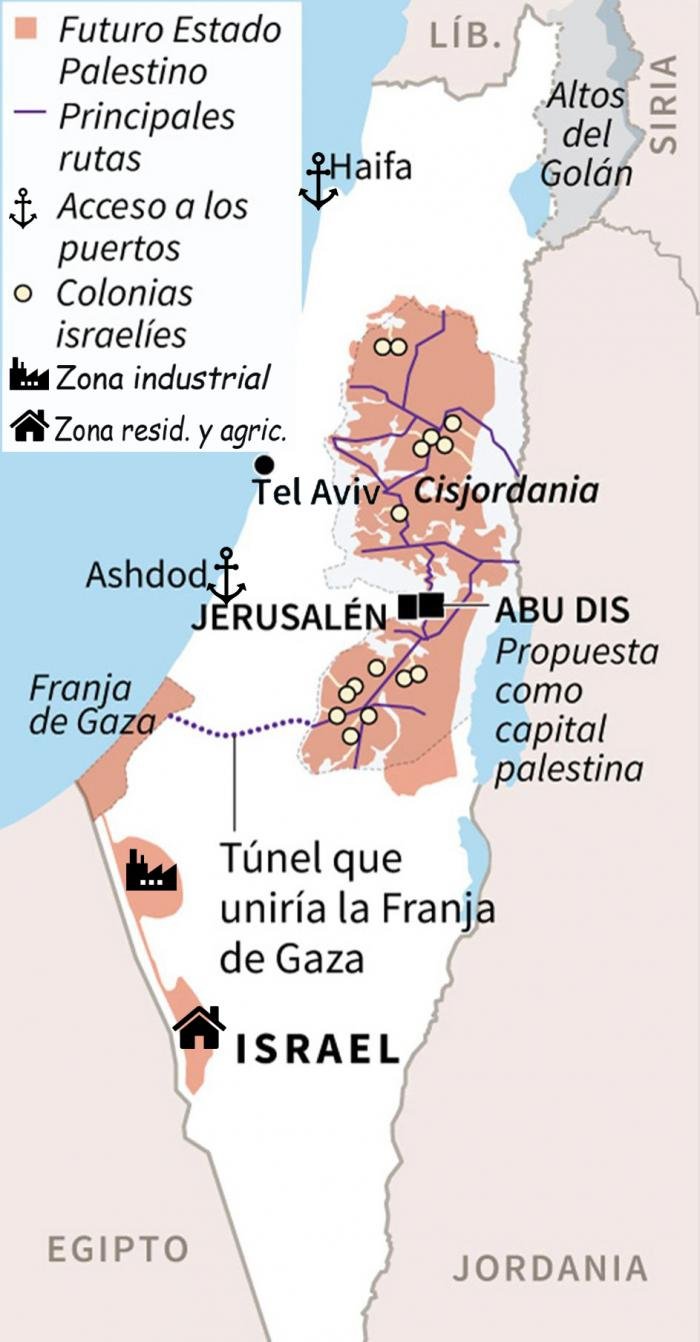
Subscribe to Blog via Email
| M | T | W | T | F | S | S |
|---|---|---|---|---|---|---|
| 1 | 2 | 3 | 4 | 5 | 6 | 7 |
| 8 | 9 | 10 | 11 | 12 | 13 | 14 |
| 15 | 16 | 17 | 18 | 19 | 20 | 21 |
| 22 | 23 | 24 | 25 | 26 | 27 | 28 |
| 29 | 30 | 31 | ||||

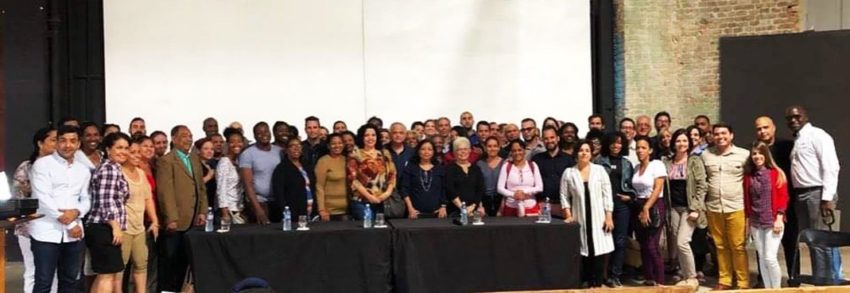
You must be logged in to post a comment.